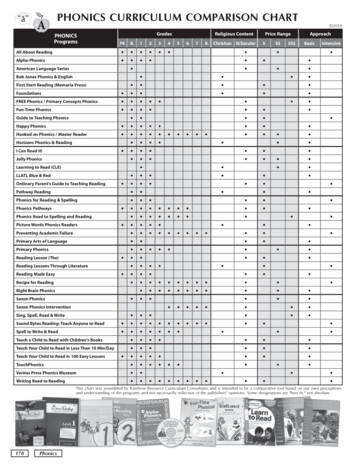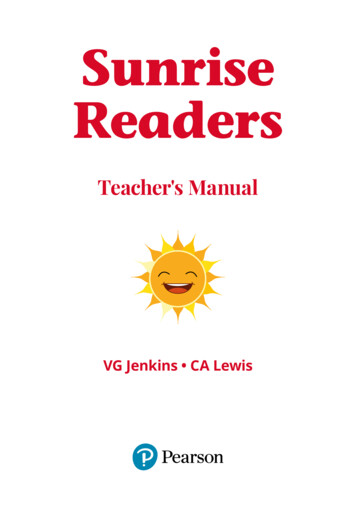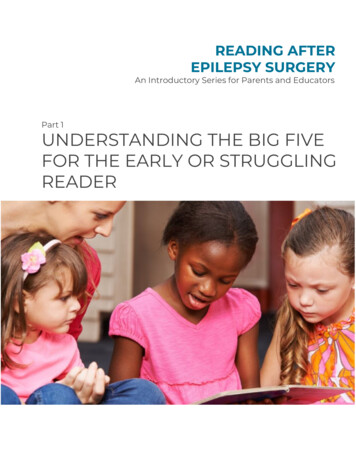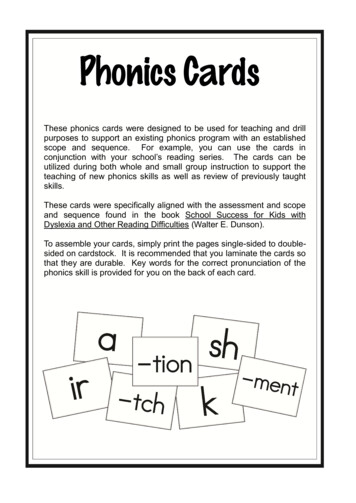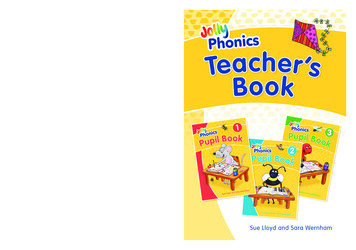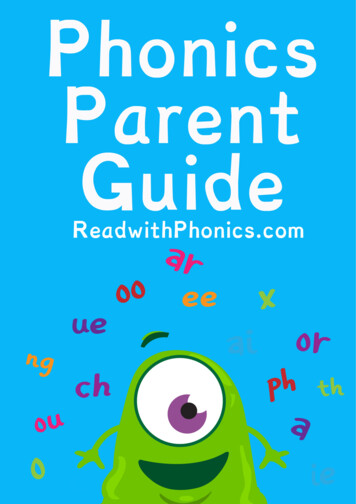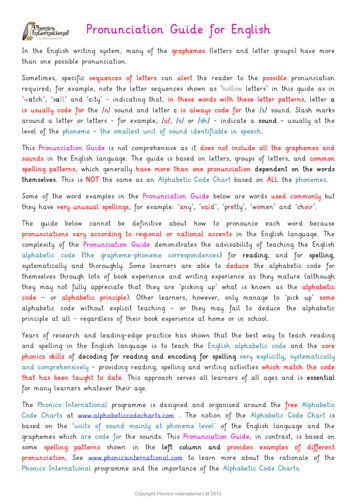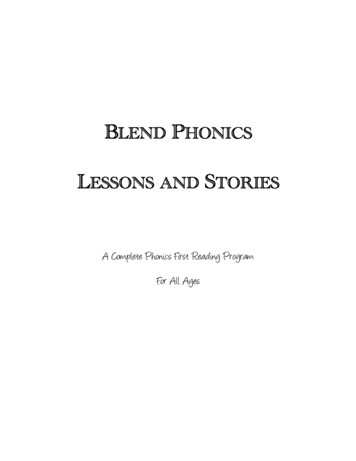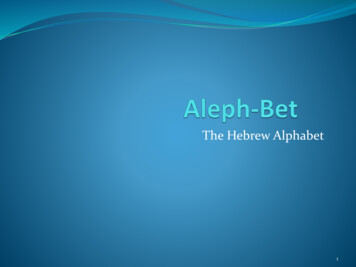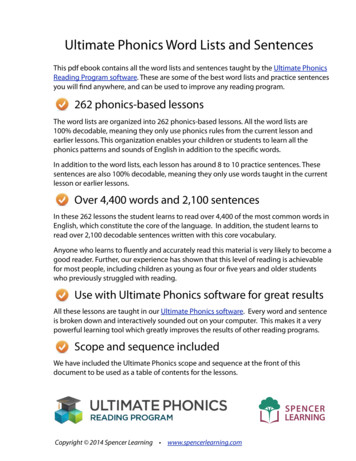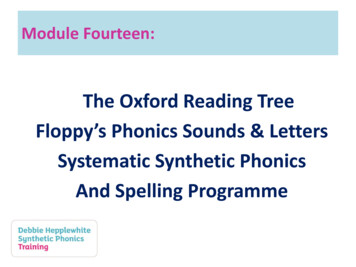
Transcription
Module Fourteen:The Oxford Reading TreeFloppy’s Phonics Sounds & LettersSystematic Synthetic PhonicsAnd Spelling Programme
Debbie’s two-pronged approachto synthetic phonics mmeIncidental: individual group class-as needed
The alphabetic codeSimple and complex codeknowledge taughtat any time, to anyone,as required
FP Teaching Sequence1. Teacher-led sessionWhole class - interactive2. Rigorous Pupil practiceIndividual but within whole class– core and fit-for-purpose
The Oxford Reading TreeFloppy’s PhonicsSounds and LettersProgramme
Create fearless readers, spellersand writers who are . interested in words relish learning and desire accuracy.whatever their unique capacity to learn!
Teaching Handbooks 1 & 2St 1 to 3continuationSt 4 to 5
Planning, Assessment & ResourcesAll StagesHandbook Plus CD-ROMof printable and editableresources includinglesson plansPhotocopiable Cumulative Texts, Assessments,and mini Alphabetic Code Chart
Poster RangeStage 1 to 4 Frieze Strips- correspond with eachSounds and Letters Book
Graphemes orspellingalternatives-across the rowsSounds- down the leftcolumns asthere are fewersounds thangraphemes
Grapheme tabletscolour-codedto match ORTstagesOrder of soundsintroduced inthe programme(same order asLetters and Sounds)
Distinguish between teaching about: The alphabet The alphabetic code
Bank of shapesAlphabetical order only sing names withan alphabet songHandwritingSay the sounds![Capital letters samecode as lower case]
VISUAL DISPLAYSelect a key display wall with very easy access forfocused phonics teaching and learning.Display permanently: The Alphabetic Code Chart The Alphabet The Tricky Words Poster/f/-ffeDisplay cumulatively:giraffe Frieze Strips; photocopiable stage 5 Friezegaffe Any tricky words to ‘focus upon’ as required Say the Sounds Posters
Photocopiable Poster RangesStage 1 to 48 Say the Sounds PostersStage 521 Frieze Posters – match theSounds and Letters Books
42 Sounds and Letters BooksPhase 1 sounds: environmental rhythm, rhyme singing, chanting percussion discussion!2 CD-ROMs
Plentyof time.1 book per2 weeks.for childrento keep upwith thelearning!2 years@ 1 bookper 2 weeks
The structure of Sounds and Letters programmeLetters and SoundsORT FP Sounds and LettersPhase 1Stage 1Phase 2Stage 1 ( ‘-le’)Phase 3Stage 2 and Stage 3( Revise and Stretch Books – Ph 5)Phase 4Stage 4 elements of Phase 5(Revise and Stretch Books)Phase 5Stage 5(In reality, ‘Phase Six’ expectations)Page 20: Sequence of Sounds and Letters books relative to Letters and Sounds
42 Sounds and Letters Books havecorrelating CD-ROM spreads
Sample screen viewsSelect the letters to watchhow they are formedDrag and dropfor spellingBlend and revealfor readingHear the sounds,point to the graphemes
CD-ROMsIndependent use –Revision and consolidation:Many ‘whole spoken words’supportive of EAL childrenand children withimpoverished languageand speech difficulties.
Inside the Sounds and Letters Books‘End pages’ not on the CD-ROMs
Cover notes in the FP Sounds and Letters booksprovide guidance for the adult to support the youngreader to blend and segment:Blending routinefor readingSegmenting routinefor spelling
Alphabetic Code Flash Cards
Multi-sensory practice and applicationActivitySheetsGraphemeTilesSay the SoundsPostersCumulativeTexts
Core skills multi-sensory Activity SheetsEssential – apply learning toCumulative Texts from Bk 4
Floppy’s Phonics fiction and non-fiction
Vocabulary, Phonics and BuildingSpelling Word BanksPhonics for reading and spelling linked towider language, pictures and story themes
HMI Sept 2011“.inspectors can see theuse of a worksheet asbeing highly effective inconsolidating learning andcan be used as an effectiveassessment tool.Worksheets therefore canbe a useful resource whendesigned specifically tomeet children's needs.”
Activity Sheet: Train all the childrenfirst Tell them in advancewhat extensionactivity to do whenthey finish the FIRSTside of the ActivitySheet Strong focus on theslower-to-learnchildrenApart from the initialtraining stage, never‘go through’ theActivity Sheetbefore the childrendo the activities!
Revision and ProgressionEach sound is revisited and morespelling alternatives are introduced
Example wordStage 5Sounds and LettersBookslist of six words
Simple, but powerful, multi-purposeCUMULATIVE TEXTS:Work at own speed: Grapheme searchDecodeComprehendSelf-dictationConvert to joined writingWrite extension sentenceIllustratePeriodic teacher dictationProvided fromthe ‘ck’ grapheme
The Phonics Exercise BookAn ordinary exercise book with lines which can beused for personalised phonics: incidental teaching, additional teaching, handwriting personalised practice (individual, group) for extension activities: e.g. copying pics fromSounds and Letters Books with spellings or captionswritten underneath, glueing in Cumulative Texts,drawing pictures, adding sentences, self-dictations,dictationsAlways have it to hand !
The Phonics FolderAn ordinary ring binder of some description forevery learner to collate: Copy of a mini alphabetic code chartCopy of an alphabet with school handwritingCopies of successive Say the Sounds sheetsAll paper-based multi-skills activity sheets andcumulative textsPart of the bookbag routine!
Let’s take justone sound ./j/
Let’s take just one sound ./j/We see j and say /j/ at the beginning of words.
But what is the code when the sound /j/ is at the end of words?For reading, we see dge and we say /j/. We never see letter j at the end!
But wait a minute, some words which start with the sound /j/ don’t alwaysstart with this letter: j Is there any code which alerts the reader to this?
How do we know when to use this grapheme [‘ge’] or thisgrapheme [‘dge’] for spelling words which end with the sound /j/?Handbooks: Pages 16 to 19 provide the answers
Practical Application
The two- session approachPage 28 Handbook 1:Session 1: A distinct teaching routineSession 2: A distinct learning routineSession 2 can follow-on, can take place later inthe day, or take place the next day!
GroupingPage 33: All children need to learn same alphabeticknowledge and same three core skillsSession 1 – teacher led /whole class slower to learn/ less attentive closest to whiteboard allow some/ all to stand up occasionally to do air writing,saying sounds, pointing to graphemes the more ‘collective’ the interaction, the better – for paceand whole class engagement
Session OneRevisit and Review:“Let’s practise our sounds andletters!”Flash Cards and/orSay the Sounds PosterTeach:“I wonder which sounds andletters of the code we’re goingto learn today?” Flash CardFrieze StripCD-ROM
Revisit and Review:Quick-fire activity with the pack ofStage 1 Flash Cards with whole class!Revise correspondences and words.Teach:Refer to new grapheme on j v w Frieze Stripand ‘teach’ new sound and grapheme withnew Flash Card /j/ j.
Select the letters to watchhow they are formedSelect the audio buttonto hear the soundCD-ROMSelect the audio buttonsto listen to the wordsTools:Try zoom on theword list!Select Chip:Hear/see the word,drag and drop for spellingSelect the picture toHear the sound and wordSelect the word bank:Blend the soundsto read the words,reveal the word!Select the graphemesto hear the soundsSelect Floppy:Hear the sounds,point to thegraphemesPicture:1.Phonemic awareness(focus sound in words)2.Languagecomprehension
Step by step guidance on Page 29
Session TwoPractise:Sounds and Letters BooksActivity Sheets“Let’s practise our skills!”Extension:Cumulative TextsPhonics Exercise Books“After the first side of yourActivity Sheet, go on to do yourgrapheme search. When youhave read the sentences, chooseone to write and illustrate.”
Spelling-with-editingThe teacher decidesthe right time to drawthe class together forthe spelling routine.Draw the class together:“Let’s work out the sounds injump – left hand, palm facing!” Say the word ‘jump’ very slowly Tally each sound to thumb and fingers ofthe left hand, palm facing Say the sounds separately How many sounds?Top left for thesound dashes Write the sound dashes (writing lines) Say the sounds whilst writing thegraphemes on the sound dashes Sound out and blend to check Tick if correct
Spelling-with-editingTop left for thesound dashesDifferentiation: Some children can be given more wordsthan others to spell, as appropriate Remember the three-beat trap soinclude some longer words for all children(support as necessary)Spare dash at the end.?Include past andcurrent ‘tricky words’j u pmj u p
Sounds and Letters BooksWhole class, groups or individuals:Extra for slower-to-learn children – pre or post the main lessonRepeat the routines: see, finger-trace/track, say, blend, discussSchool ‘practice books’ and optional home useafter the main content has been completed.‘End pages’ – revision and consolidation:Revision after the focus correspondences have been introducedConsider how you could use the end pages for oral activities,and then write-and-draw activities in the phonics exercisebooks.
Grapheme TilesAt school Pages 90 to 98 Planning, Assessment & Resourcesuse to spell dictated wordsmanipulate the tiles, followed by handwriting practiceplay Pairs Game or Snaplaminate and use with magnetic tape – add to teacher’smagnetic whiteboard as new ones are introducedAt home Pages 99 to 117 tiles for home include the key picture word on separate tiles guidance given for parents – several ways to use them withchildrenCan also be used at school
Additional Activities - Stages 1 to 3Stage 1At homeOut in TownAt the ParkFun at SchoolAt the FarmAt the MatchSuggestionsbook by bookPages 39 to 46Stages 1 , 2, 3Two creativeactivities perStageTake a walk through Teaching Handbook 1.
Assessment for the basicsWhat are we teaching?So, what do we assess?
Knowledge of the ALPHABETIC CODE the letter/s-sound correspondences - and the sub-skills and skills: From sound to print for decoding ‘See the graphemes, say the sounds’ From print to sound for encoding ‘Hear the sounds, select/write the graphemes’Write upper case and lower case letters correctly on writing linesWord level reading - sound out and blend: all-through-the-printed-word(only ‘sound out’ when necessary)Word level spelling - orally segment: all-through-the-spoken-word: select correct grapheme tiles write with correct spelling alternatives – pull graphemes from memoryTricky common words – reading and spelling/writingSimple sentences (at code knowledge level) with punctuation for readingThese are constantly monitored with for spelling/writingthe programme’s routine resources.
AssessmentEngage the children with self-assessment from thebeginning: ‘Do you know it?’, ticking, underlining,circling, ‘What do you need to practise some more?’Clip folders: Say the Sounds Posters, Activity Sheets,Mini Alphabetic Code Chart, Mini Alphabet –tracking, celebrating, sharing progress information,informing homePeriodic formal assessments: – in Planning andAssessment Resources Handbook, utilise resourceschildren use regularly, use Cumulative Texts forteacher-led dictation (matched groups)
AssessmentPages 28 – 52: Suggestions and assessment resources ‘Entry’ baseline assessment (suggestions Page 30) Letter/s-sound Correspondences assessment sheets Reading and Spelling assessments sheets Oral Segmenting assessment sheet
PlacementWhen the programme is ‘new’, consider undertaking aclass-by-class baseline assessment of letter/s-soundcorrespondence knowledge (alphabetic code).From the results, find a ‘best fit’ starting point for thewhole class or large groups. Avoid multiple groupswherever possible.Fill in personal code knowledge gaps using theprogramme’s materials collated in the clip folders.
Year One Phonics Screening CheckChildren will already be very skilled at decodinghundreds of new words independently via theActivity Sheets and other resources.Many of these words will not be in the children’sexisting oral vocabularies – therefore they are the‘equivalent’ to (nonsense) pseudo-word decoding.Just prior to the check, play a game of decoding somenonsense-words as ‘names’ for some ‘monsters’which is the same method used in the screeningcheck to present the non-words.
Planning and AssessmentThree main planning tools:1. Teaching sequence flow charts2. Planning and Record Grids3. Book-by-book plansAssessment resourcesCumulative TextsGrapheme TilesGrapheme Tiles with picturesEditable CD-ROM including lessonplans – examples of planning in thePAR Handbook
PlanningThree main planning tools:Pages 9 – 13: Teaching Sequence flow chartsStage 1Stages 1 to 3Stages 4 to 5Pages 14 – 19: Planning and Record gridsPages 20 – 27: Book-by-Book plansStages 1 to 5Stages 1 to 5
PLANNING and RECORD GRIDSSessions 1 and 2Book 1/s/ sBook 2Book 3Book 4Book 5Book 6/i/ i/g/ g/k/ -ck/h/ h/l/ l/a/ a/n/ n/o/ o/e/ e/b/ b/l/ -ll/t/ t/m/ m/k/ c/u/ u/f/ f/ul/ -le/p/ p/d/ d/k/ k/r/ r/f/ -ff/s/ solidateConsolidateDate and NotesSessions 3 and 4Date and NotesSessions 5 and 6Date and NotesSessions 7 and 8Date and NotesSessions 9 and 10Date and NotesPink column can be up to two weeks’ work
BOOK-by-BOOK PLANS: Book 1SessionResourcesSession 1Session 2/s/ s/a/ a/t/ t/p/ pFriezeRevisit and ReviewRevisit and ReviewRevisit and ReviewFlashcards-Revise the letter-soundcorrespondence /s/ s usingthe Flashcard and theFrieze.-Revise the letter-soundcorrespondences /s/ s and /a/a using the Flashcards and theFrieze.-Revise the letter-soundcorrespondences /s/ s, /a/ aand /t/ t using the Flashcardsand the Frieze.FlashcardsTeachTeachTeachTeachInteractive WhiteboardCD-ROM 1-Teach the new lettersound correspondence /s/ susing the Flashcard andBook 1 on the InteractiveWhiteboard CD-ROM.-Teach the new lettersound correspondence /a/a using the Flashcard andBook 1 on the InteractiveWhiteboard CD-ROM.-Teach the new letter-soundcorrespondence /t/ t using theFlashcard and Book 1 on theInteractive Whiteboard CDROM.-Teach the new letter-soundcorrespondence /p/ p using theFlashcard and Book 1 on theInteractive Whiteboard CDROM.Sounds and Letters Book1PractisePractisePractisePractise-Practise the letter-soundcorrespondence /s/ s usingSounds and Letters Book 1and Activity Sheet 1.-Practise the letter-soundcorrespondence /a/ a usingSounds and Letters Book 1and Activity Sheet 2.-Practise the letter-soundcorrespondence /t/ t usingSounds and Letters Book 1 andActivity Sheet 3.-Practise the letter-soundcorrespondence /p/ p usingSounds and Letters Book 1 andActivity Sheet 4.Activity Sheets 1, 2, 3 and4Grapheme TilesConsolidate-Use Sounds andLetters Book 1 torevise the set ofsounds andgraphemes andbuild confidence.Use the activitiesat the end of eachbook toconsolidatelearning.-Complete the CDROM activitieswith the children,supporting asnecessary.-Complete anycore or extensionactivities asnecessary.Apply-Use the Grapheme Tiles forspelling practice.Examples of planning shown in the PAR Handbook, planning on CD-ROM
The end of the course!WELL DONE!
The Phonics Exercise Book An ordinary exercise book with lines which can be used for personalised phonics: incidental teaching, additional teaching, handwriting personalised practice (individual, group) for extension activities: e.g. copying pics from Sounds and
